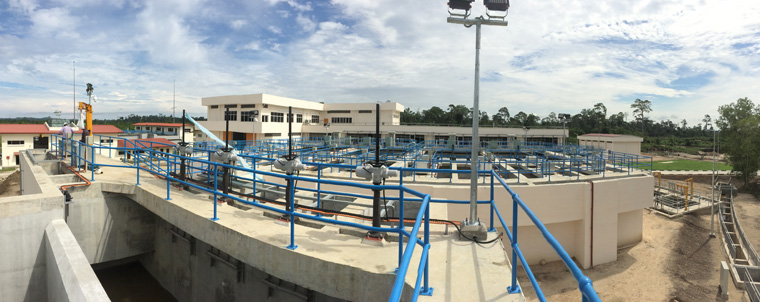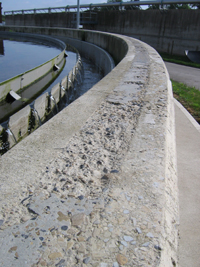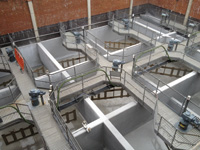
Chris Lloyd and Graham James of Flexcrete Technologies give detail of the introduction of AMP6, and the need to maintain and refurbish structures within the water industry.
The water industry continues to face major challenges with regard to factors such as managing environmental impact, meeting affordability targets and maintaining assets. In order to operate within the stringent regulatory framework, many water companies have changed their business models, impacting on the way they work with their construction partners and wider supply chain.
Ofwat has driven a change of priorities, generating a greater focus on the service delivered to the end customer. The introduction of AMP6, the sixth asset management period, has had a huge impact and has resulted in water companies making concerted efforts to drive integration and collaboration by focusing on efficiency, customer outcomes, innovation and asset maintenance.
Many water companies have already completed major strategic investment programmes, and have shifted the focus of their operations to the maintenance of their asset base rather than new construction. Under Ofwat’s service delivery framework, a key aspect of asset management is deriving the maximum service life from an asset as opposed to simply specifying the cheapest materials. Ofwat has followed other regulatory bodies by adopting a totex (total expenditure) approach which stimulates thought processes to drive the lowest whole life cost of assets and projects within the water industry. Totex encourages long-term investment decision making based on best whole life cost performance, not just the initial cost.
Mainten ance and Refurbishment is Essential
ance and Refurbishment is Essential
Water retaining structures are wide and varied in nature and can range from service reservoirs and water towers in the water supply process to stormwater tanks and support chambers in wastewater treatment. Many of the structures are constructed from reinforced concrete and it is vital that they are effectively maintained and refurbished, as chemical and mechanical influences can severely degrade concrete over the years. Maintenance and refurbishment is essential in order to ensure that water transmission is not interrupted, that the quality of water is not adversely affected and that structural integrity is maintained.
Achieving the Original Design Life of Concrete
There are specialist repair materials and cementitious coatings available that can help to achieve the original design life of reinforced concrete water assets, whilst allowing stringent quality and environmental standards to be maintained. With many different options available on the market, it is important to consider products that have a successful track record of use in the water industry and are backed by independent approvals such as CE marking in accordance with BS EN 1504, the pan European standard for concrete repair. Leading products for use in contact with potable water are also listed under the Water Regulations Advisory Scheme (WRAS) and are approved under Regulation 31 of the Water Supply (Water Quality) Regulations 2000.
If manufacturers are able to offer a range of products for various applications – whether this be concrete repairs, general concrete finishing or protection from carbonation – they can offer a single source solution, thus avoiding the cost and inconvenience associated with sourcing alternative products from a mass of different suppliers. Leading manufacturers employ experienced staff who will work with clients to help determine which products are best suited to the technical and budgetary parameters of a given project.
Environmentally Friendly and Sustainable
In many instances, it is also important to consider the use of environmentally friendly and sustainable repair materials. Engineering quality mortars and cementitious coatings are available that are water-based, ultra-low odour and solvent-free, making them safe to apply even whilst facilities are in operation. In some countries, additional taxes must be paid for materials that release Volatile Organic Compounds (VOC’s).
Asset managers will generally favour systems that minimise environmental impact during preparatory works. Polymer modified cementitious mortars and coatings are ideally suited for application directly onto surfaces that have been cleaned with high pressure water jetting techniques. A dry substrate is not required, and provided there is no running or standing water, the contractor may proceed immediately with the installation without the expense and inconvenience incurred when it is necessary to wait for a structure to dry out. Downtime is also a crucial consideration when specifying repair and coating materials, but the refurbishment of water assets need not always lead to lengthy shutdown periods. Cementitious repair mortars are available that are exceptionally rapid curing, making them ideal for applications where speed of reinstatement is important.
Deterioration of Reinforced Concrete
The deterioration of reinforced concrete is caused by a number of chemical and physical influences. Soft water attack on concrete is a major problem in the water industry, as it effectively acts as a high performance solvent and dissolves the lime that is formed as a by-product of the cement hydration process, leaving the concrete susceptible to chemical attack from acids including weak carbonic and humic acid.
Nevertheless, there are specialist technical mortars and cementitious coatings available that exhibit excellent resistance to attack from soft water. Key products incorporate pozzolanic materials and microsilica. Pozzolans react with the lime to form high levels of insoluble calcium silicate hydrates with very good chemical resistance. Microsilica effectively ‘mops up’ lime and affords enhanced resistance to chemical attack. Furthermore, the polymers incorporated into these materials form a protective film on the surfaces of the hydrates, subsequently enhancing the chemical resistance even further.
Key products can also withstand immersed conditions without detrimental effect and have been specified for many contracts where water authorities have experienced specific problems with soft water attack. As an example, repair materials and protective coatings have been used to repair over 30 reservoirs as part of the Northern Ireland Framework Rehabilitation Programme. Virtually all of the structures were suffering from soft water attack and in some cases, the attack was so severe that repair mortars were first used to reinstate the integrity of the substrate before the final coating could be applied.
A key product used to provide the necessary long term protection is Cementitious Coating 851 – a two component, waterborne cementitious modified polymer coating which is ideal for the structural waterproofing of concrete, resisting positive and negative pressure under a 100 metre head. It forms a hard, highly alkaline coating which not only protects concrete from the effects of aggressive acid gases, moisture and chlorides, but also has enhanced chemical resistance to soft water. 851 provides effective waterproofing on precast and in-situ reinforced concrete and a 2mm coating of Cementitious Coating 851 provides equivalent waterproofing properties to 1000mm of good quality concrete cover. Being cement based, it chemically reacts with the substrate to become an integral part and will have a design life equal to that of the concrete to which it is applied. Independent testing carried out at the VINCI Construction Technology Centre has confirmed that Cementitious Coating 851 will provide an effective barrier to chlorides for at least 27 years, a benchmark which is unparalleled throughout the global market.
Water Ingress
Water ingress is another common problem associated with water assets, whereby failure of concrete can lead to water loss or the ingress of groundwater. This is typical on reservoir roofs and there are products available such as Cemprotec Elastic, a two component, cementitious modified, elastomeric coating which is designed for the waterproofing and protection of concrete where further movement is expected. It has proven root resistance properties, confirming suitability for green roof applications for the many situations where reservoirs are subsequently covered to blend in with the countryside.
Water seepage through construction joints and cracks can have a number of consequences, including leaching of the concrete, corrosion of the reinforcement, attack from aggressive elements into the concrete matrix, freeze/thaw damage and ultimately, leakage of fluids either into or out of a facility. The specification of effective repair materials can halt future deterioration and prevent unacceptable fluid migration. Products such as the Cemprotec 2000-S bandage system have been introduced as an alternative to other Hypalon® bandage systems which utilise epoxy adhesives and require hazardous solvents to activate the tape. Cemprotec 2000-S is WRAS certified, does not require solvent activation, has 600% elongation and achieves excellent bond when anchored directly into an environmentally friendly cementitious coating.
Chemical Attack
The most widely feared mechanism for the erosion of concrete in sewerage systems is bacterial in origin. Normal domestic sewage is slightly alkaline and does not contain sulphates in sufficient concentrations to attack concrete directly. The damage which occurs is due to sulphuric acid produced by certain bacteria as a result of changes occurring in the sewage. When conditions are such that oxygen in the sewage becomes depleted, anaerobic organisms, which do not use atmospheric oxygen but obtain their requirements for growth from salts, reduce the sulphates and other organic sulphur compounds in the sewage to form hydrogen sulphide. Contrary to popular belief, hydrogen sulphide does not directly attack the concrete, but will dissolve in moisture particularly on the crown or soffit of the sewer and on the walls above liquid level to form a weak acidic condensate. However, aerobic organisms of the Thiobacillus species will oxidise gasses in the atmosphere to exacerbate the situation by producing sulphuric acid, which readily attacks concrete.
It is therefore important that any products used in these critical areas, where the rate of deterioration can be quite rapid, exhibit excellent resistance to sulphuric acid attack. One product which is often used in the wastewater industry is Cemprotec E942. This is an innovative, two component, water based cementitious coating that benefits from modification with both a thermoplastic polymer as well as an epoxy resin to provide a hard wearing surface with greatly enhanced chemical and abrasion resistance. The product is very versatile with the ability to be applied to both concrete and ferrous metals without a primer and has a long track record of successful use in digester tanks where the most onerous conditions are found.
Physical Damage
Concrete dete rioration caused by physical influences such as abrasion and impact damage is more immediately apparent than chemical processes. This damage can affect the structural integrity of water assets, which in turn severely affects the durability of concrete. The perimeter walls of settlements tanks often show severe erosion where the agitator arms travels. Whilst care must be taken to ensure that any cracks in the substrate are identified and dealt with, Fastfill rapid setting repair mortar, based on a micro-fine Portland cement modified with Sulpho-aluminate, has been successfully used as it combines excellent chemical and abrasion resistance with rapid return to service.
rioration caused by physical influences such as abrasion and impact damage is more immediately apparent than chemical processes. This damage can affect the structural integrity of water assets, which in turn severely affects the durability of concrete. The perimeter walls of settlements tanks often show severe erosion where the agitator arms travels. Whilst care must be taken to ensure that any cracks in the substrate are identified and dealt with, Fastfill rapid setting repair mortar, based on a micro-fine Portland cement modified with Sulpho-aluminate, has been successfully used as it combines excellent chemical and abrasion resistance with rapid return to service.
Carbonation Attack
Carbonation, which is the breakdown of the alkaline environment surrounding steel reinforcement, is another major problem in untreated concrete infrastructure exposed to atmosphere. Carbon dioxide migrates through cracks and pores in concrete, reducing the pH of the alkaline environment from 12-13 to around 9, inevitably leading to corrosion and concrete spalling. There are high performance coatings on the market that offer many years’ protection against carbonation attack, including the Monodex range of decorative elastomeric coatings which benefits from independently proven diffusion resistance to carbon dioxide.
As an example of a highly cost-effective option, Monodex Ultra will provide the same level of cover as 500mm of good quality concrete whilst also providing a defence against the weather. Applied in two coats to give a dry film thickness of 130µm, Monodex Ultra will achieve a service life in excess of 10 years before first major maintenance.
In summary, the shift in emphasis towards service quality and asset maintenance is particularly important and it demonstrates the need to maintain and refurbish water assets. Investing in specialist repair and protection materials can extend the life of structures significantly and protect them from future degradation.


